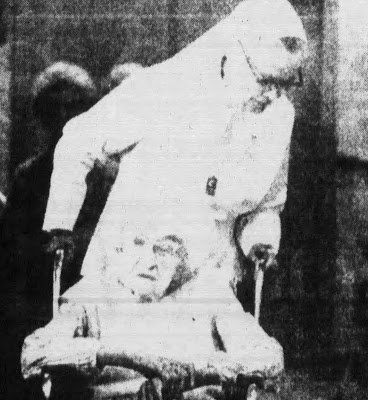LA HERMANA JULIANA DE SAIPÁN, ISLAS MARIANAS
Una vez conocí a una hermana chamorra que no me hablaba en
chamorro. Ella solo me hablaba en español.
En 1992, viajé a España para investigar en nuestros archivos
capuchinos en Pamplona, donde se almacenan muchos documentos relativos a Guam,
principalmente sobre la Iglesia desde 1900 hasta 1941.
Después de una semana de investigación en Pamplona, mi
siguiente visita fue a Bérriz, un pequeño pueblo no muy lejos de Pamplona. Si
tuviera un coche, podría haber conducido desde Pamplona a Bérriz en dos horas.
Pero yo no tenía coche y cogí el tren, por lo que tardé casi todo el día en
llegar a mi destino.
Mi objetivo en Bérriz era conocer a algunas hermanas
mercedarias españolas mayores que alguna vez habían servido en Saipán desde la
década de 1930. ¡Pero no sabía que allí también había una hermana mercedaria
chamorra!
Su nombre era Sor Juliana Roberto de la Cruz, de la familia
Bisco de Saipán. Había nacido en 1912, así que tenía 80 años cuando la conocí.
Sus padres, Vicente San Pedro de la Cruz y María Sablan Roberto, nacieron en
Guam pero se mudaron a Saipán donde se conocieron y se casaron en 1904.
Juliana estaba en el primer grupo de mujeres de Saipán que
se unieron a las hermanas mercedarias después de la segunda guerra mundial.
Ella ministró durante muchos años, lejos de Saipán, así que nunca la había
visto antes. Incluso las mercedarias chamorras de Saipán que nunca trabajaron
en Guam, las conocí por haberlas visto en Saipán, pero Hermana Juliana ya hacía
mucho tiempo que se había ido de la isla.
Finalmente conocí a esta (para mí) sorprendente hermana
chamorra en España. No recuerdo ahora si mis primeras palabras con ella fueron
en chamorro o en español; Conociéndome, le habría dejado comenzar el diálogo y
elegir el idioma.
Naturalmente, hubiera querido explicarle quién era yo y cuál
era mi conexión con Saipán. Recuerdo claramente tratar de decirle todo eso en chamorro,
y ella me entendía, porque cuando me contestaba, sus comentarios seguían a lo
que yo estaba diciendo, pero lo decía todo en español.
Cuando hablaba en español, lo decía con un tono y una
pronunciación chamorros muy identificables. Yo continuaba escuchando palabras
en español, pero la "musicalidad" era chamorra. Así que seguí en
chamorro cuando me tocó hablar. Sin embargo, su completa confianza en el
español (no me dijo una palabra en chamorro) me impresionó. Eventualmente
también cambié al español, y ese día España no pudo escuchar una conversación
en chamorro.
Hermana Juliana parecía muy interesada en lo que tenía que
decirme; Conocí a su familia en Saipán. Hablamos de cómo estaban, cuáles eran
las últimas noticias en Saipán, un poco de ella y un poco de mí. Fue la primera
y única vez que la vi, y la impresión permanece conmigo hasta el día de hoy.
Esas ganas de hablar chamorro lejos, muy lejos de casa, con una mujer chamorra
cincuenta años mayor que yo, pero que sólo me hablaba en español. ¡¿Con qué
frecuencia llegaría a experimentar eso?!
Hermana Juliana se había unido a una comunidad española de
hermanas. Cuando se unió a ellas, todas hablaban en español y solo una, creo,
Hermana Beatriz (anteriormente Angélica), hablaba algo de inglés. Reclutaron
nuevas hermanas de diferentes partes de Micronesia: Palaos, Chuuk, Ponapé y
Saipán. El inglés era desconocido para ellas en aquella época, por lo que el
español fue el idioma dominante en la comunidad de Micronesia hasta algunos
años más tarde, cuando pasó suficiente tiempo para que aprendieran inglés.
Pero Hermana Juliana eventualmente dejó Micronesia y comenzó
a servir en los Estados Unidos. Una de sus últimas asignaciones fue ayudar a
los ancianos en una instalación mercedaria en Kansas City, Missouri. Luego se
retiró a la casa matriz de las mercedarias en Bérriz, España.
Todos esos años lejos de las Islas Marianas hicieron que
Hermana Juliana dejara de hablar mucho el chamorro y se acostumbrara a hablar
cada vez más el español, el idioma de la mayoría de las hermanas. Debió seguir
comunicándose en chamorro con su familia, que no sabía español. Pero, por
alguna razón, nosotros solo conversamos en español.
En cierto modo, Hermana Juliana me recuerda a los
innumerables hombres chamorros que dejaron para siempre las Islas Marianas en
los barcos balleneros durante el siglo XIX y terminaron viviendo una nueva
vida, vistiendo ropa nueva, degustando comida diferente y hablando otros
idiomas porque tenían poca gente, a veces nadie, con quien hablar chamorro.
Escuchar a la hermana hablar español con acento chamorro
también me llevó atrás en el tiempo a 1800 cuando muchos chamorros hablaban un
español excelente. Sabemos esto porque muchos documentos gubernamentales
escritos en las Islas Marianas en perfecto español de elevado nivel, fueron
escritos por empleados y funcionarios chamorros. Pero supongo que muchos, tal
vez la mayoría, lo hablaban con acento chamorro.
No muchos años después de que la conocí, Hermana Juliana fue a su eterna recompensa y está enterrada en España. En 1668, España había llegado a las Islas Marianas cuando San Vitores inició la misión católica, y uno de sus frutos 300 años después, Hermana Juliana, pasó de las Islas Marianas a España y sus restos aún están allí. Descanse en Paz.



No comments:
Post a Comment